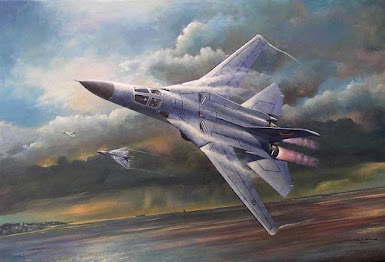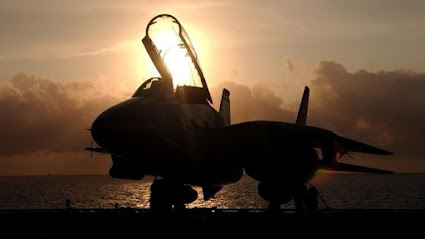The general dynamics f-111 aardvark was ruling the sky for years, but due to its high maintenance and also cost of maintenance was more so they were trying to find a substitute for f-111, the plane was too hefty for carrier service. So Grumman came up with a new idea called F-14 Tomcat which was dedicated to the US Navy.
source: internet F-111During the development of the aircraft, the designers were more concentrated on speed, to achieve a super speed the wing design must be a short and stabby wing or a highly swept wing .the designers thought that they need to make two different types of wings so this lead to choose a variable-sweep wing.
F-14 is a remarkable aircraft.when she pushes her wings back the real action begins and she could fly at supersonic speeds. She was the first member of the teen series fighter ( it is a mane for the team of combat aircraft in the US).
She was also served as an escort attack aircraft when armed with sparrow missiles. Due to her bubble canopy, the pilots were about to get 360° visuals. The wing geometry was swinging automatically during flight. When she likes to cruise at supersonic speed she uses a swept-back wing and at lower speed flight she uses swing forward wing geometry With her caring wing, she could climb faster than f-4 and also had a good amount of stability due to her twin-tail arrangement.
F-14 has a 20mm M61 Vulcan Gatling cannon on the left side. what makes her really strong was here wide varieties of weapons like AIM-54 phoenix,aim-7 sparrow and aim-9 sidewinder anti-aircraft missile .she had a very good widely spaced nacelles.
source: internet F-14She could vary her wings b/w 20° to 60° in flight. since it was controlled automatically by central air data computer which makes easy for the pilot this mechanism works so good that it maintenance wing sweep at the optimum lift to drag ratio as the Mach number varies .pilot can also vary the sweep manually as he desired.when she is parked she could sweep the wing up to 75°.
The craziest thing is ailerons are not fitted. the role control is been done by the wing-mounted spoilers at low speed and at high-speed tailerons are there to give role control. To increase the lift both during landing and combat full-span slats and flaps are used slats are set at 17° during landing and 7° at combat. Flaps are arranged at 35 at the landing and 10 ° at Combat.
They used a two triangular-shaped retractable surface called gloves vanes, were deployed in the forward part of the wing glove, it was automatically extending by FCS at high cruising speed .the the main purpose of these parts was to increase additional lift, this will help in compensating for Mach tuck at high speed. When wings are sweepback the aerodynamic center goes back .since the center of gravity is the head of the AD center they are too stable.
source: internet F-4Since the AD center is too far from CG also requires a higher tail deflection to keep the plane in equilibrium .so they have glove veins to bring AD. center forward a bit. The flat area in the fuselage b/w the nacelles is used to store the fuel and avionics system. Mach tuck: it is an aerodynamic effect caused when the nose of the aircraft tends to pitch down as the airflow around the aircraft or the wing reaches supersonic speed. The main cause of Mach tuck is by two things, due to the moment of the center of pressure of the wing and a decrease in the wing downwash velocity at the tailplane Mach tuck can be seen usually in delta-winged aircraft with no foreplane or tailplane, another Particle example is Lockheed p38 even some designs may not have these tendencies like Fokker f28 fellowship. Mach tuck on any given design is affected by the thickness of the airfoil, due to the sweep angle of the wing the placement of the tailplane by relating the main wing.
source: internet F-111When it comes to the engine the f-14 was initially equipped with two Pratt and Whitney TF30 an augmented turbofan engine, each producing 93Kn of thrust which was sufficient for her to cruise at Mach 2.34 .the rectangular air inlet had equipped with a movable ramp and bleed door De Laval nozzle was also fitted to the exhaust. De Laval nozzle is a tube that is punched in the middle, making a carefully balanced, asymmetric hourglass shape .it is used to accelerate a hot pressurized gas to higher supersonic speed in axial thrust. Due to this property, it is widely used in-stream turbine and rocket engines nozzles and also in the supersonic jet engine after lots of development and upgrades the f14 A, B, D had new GE F110 engine.
Landing: to reduce the speed while landing in the carrier they already have a high swept-back wing and also have single slobber slats and flaps. the landing speed is 114 knots.
source: internet F-4Specifications:
. Crew 2
. Length 19.13m
. Wingspan 19.545 m
. Lower wingspan 11.646m
. Height 4.9m
. Wing area 52.5m^2
. Fuel capacity 7,348kg
. Max takeoff weight 33,725 kg
. Gross weight 27,669 kg
. Empty weight 19,838kg
Armament
Guns: 1× 20 mm (0.787 in) M61A1 Vulcan 6-barreled Gatling cannon, with 675 rounds
Hardpoints: 10 total: 6× under-fuselage, 2× under nacelles and 2× on wing gloves[187][N 3] with a capacity of 14,500 lb (6,600 kg) of ordnance and fuel tanks[188],
Rockets:
7x LAU-10 rocket pods (for a total of 28 rockets)
Others:
Tactical Airborne Reconnaissance Pod System (TARPS)
LANTIRN Targeting System (LTS) pod (AN/AAQ-14)
2× 267 US gal (1,010 l; 222 imp gal) drop tanks for extended range/loitering time
Missiles:
Air-to-air missiles: AIM-54 Phoenix, AIM-7 Sparrow, AIM-9 Sidewinder
Loading configurations:
2× AIM-9 + 6× AIM-54 (Rarely used due to weight stress on airframe)
2× AIM-9 + 2× AIM-54 + 3× AIM-7 (Most common load during Cold War era)
2× AIM-9 + 4× AIM-54 + 2× AIM-7
2× AIM-9 + 6× AIM-7
4× AIM-9 + 4× AIM-54
4× AIM-9 + 4× AIM-7
Bombs:
JDAM precision-guided munition (PGMs)
Paveway series of laser-guided bombs
Mk 80 series of unguided iron bombs
Mk 20 Rockeye II
Avionics
Hughes AN/APG-71 radar
AN/ASN-130 Inertial navigation system, Infra-red search, and track, AAX-1 TCS
Remotely Operated Video Enhanced Receiver (ROVER) upgrade






















0 Comments